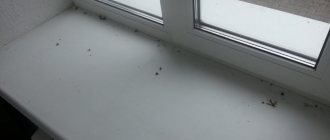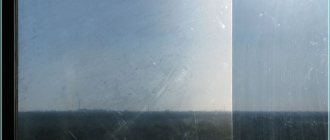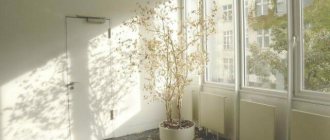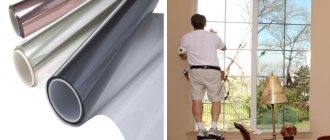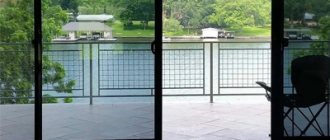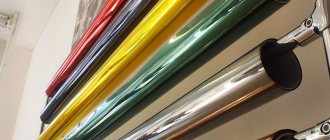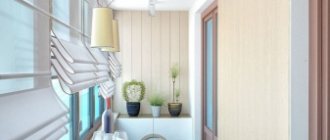If new plastic windows do not create a cozy atmosphere, the situation can be corrected. Tinting the windows in your apartment will protect you from prying eyes and from the hot rays of the sun. Some types of houseplants need less bright light. At the same time, one cannot ignore that window tinting film does not transmit the full spectrum of sunlight. You will be forced to turn on the electric lights before your neighbors. In any case, the choice is yours. The purpose of this article is to talk about what tinting is and how to do it yourself.
What films are used for window tinting?
- Sun protection film. Window tinting with such a film is necessary if the windows are facing south. Solar energy will be reflected to a large extent and the indoor temperature will decrease. Window tinting with solar control film makes it possible to save energy by turning on the air conditioner less often. Glare will disappear from TV and computer monitors. This film is also recommended for the kitchen: the refrigerator will operate normally. It comes in different light transmittance.
- Mirror tinting of glass windows is usually used in apartments on the lower floors of multi-storey residential buildings and in offices whose windows overlook a crowded street. In this way, you can completely hide the interior of the room from prying eyes. Mirror tinting of windows eliminates the need to keep blinds and curtains closed when the lights are on. At the same time, from the outside of the room, the glass will appear completely transparent, but this effect disappears with the onset of darkness.
- Decorative film is necessary to maintain a certain style of the interior of the room. Its color is chosen in accordance with other elements of the room’s decoration. In some cases, it is necessary to apply several layers of different shades to achieve the desired effect.
- Protective tinting: with its help you can significantly protect people in the room from the consequences of vandals. The glass will not be easy to break, and if this happens, injuries and cuts will be excluded. The glass will not shatter into many small pieces, but will simply crack (a “cobweb” is formed). Such glass is often installed in seismically unsafe areas.
- Energy-saving film reflects infrared radiation back into the room, making it possible to reduce heat loss in winter by a third. At the same time, by transmitting only the visible part of the spectrum of sunlight, the film does not allow the air to become very hot in summer.
Varieties
Several types of polymer products for sun protection windows are widely available, which differ in chemical composition, manufacturing technology and technical characteristics:
Metallized
The polymer product is subjected to metal spraying, the amount of which determines the light transmittance and reflectivity.
Advantages:
low cost;- wide range of shades, dimensions, thicknesses;
- suitable for residential premises;
- does not heat up in the sun, which eliminates the release of toxins.
Flaws:
- efficiency does not exceed 50% - 60% reflection of ultraviolet rays;
- in hot weather the room continues to heat up.
Scope of application:
- residential buildings;
- apartments;
- office buildings of class B, C and below.
Average prices: from 400 – 600 rubles. for 1 roll with a width of 0.5 m and a length of 20 m.
Tablecloths
High-tech products from an increased price category, metal spraying is applied through electrolysis, which contributes to the uniform distribution of particles over the plane of the film.
Advantages:
- reflective ability exceeds 90%;
- guarantee of UV protection;
- increased mechanical strength.
Flaws:
- high price;
- complexity of the device due to thick material;
- a small selection of products with low light reflectance.
Scope of application:
- class A office centers;
- business class houses with stained glass windows.
Average prices: from 600 – 700 rubles. for 1 roll 0.5 x 10 m.
Pattern-metalized
The most functional and expensive product, the metallized coating for which is produced using a combined method. The first layer is created through the exchange of ions during electrolysis, the second is a protective mechanical spraying.
Advantages:
- the highest class of ultraviolet protection – up to 98%;
- avoiding heating of the material itself.
Flaws:
- high production costs are reflected in the price;
- limited use of the product in residential buildings.
Scope of application:
- facilities for holding entertainment and cultural events;
- covering stained glass glazing of modern high-rise buildings of premium class.
Average prices:
- from 1100 rub. for 1 roll – 0.5 x 10 m;
- from 1700 rub. per roll 0.9 x 10 m.
Mirror
Special attention should be paid to mirror film, the production of which uses silver ions sprayed in a thin layer onto a polymer plane.
The thickness of such films starts from 60 microns. Presented on the market in a wide range, they contribute to the absorption of up to 80% of solar energy , and have an increased reflectance of UV rays - up to 97%.
Among the disadvantages is the risk of destructuring the mirror coating if cheap materials are purchased.
Considering that mirror polymer films belong to the class of metallized products, their cost does not exceed 500 - 700 rubles. for 1 roll with a length of up to 20 m.
Tint film application technology
To complete the job you must have:
- construction (or stationery) knife with a sharp blade;
- spray bottle filled with soap solution;
- rubber spatula;
- tint film in the required quantity.
Any type of film is applied in the same way. Tinting plastic windows: step-by-step instructions.
- On a flat surface, you need to unroll the roll and lay out the film. The part should be cut out of the film according to the dimensions or a pre-made template. The cut line is marked with a thin marker with a small margin (about 2 cm).
- The glass must be thoroughly cleaned of dirt and degreased. After this, you need to moisten the surface with soapy water and clean it with a rubber spatula. The procedure is repeated several times.
- Before gluing the film, the glass is again generously covered with soapy water.
- The film is released from the protective layer. This must be done carefully, removing the “liner” together, from one edge.
- To make gluing the film easier, you need to moisten its adhesive side with a soap solution using a spray bottle. Thanks to this, the film will not stick tightly to the glass for some time, during which time its position can be adjusted.
- Begin gluing the film to the glass from above: applying the edge, you need to carefully smooth the cut out part onto the glass with your hands. You should inspect everything and make sure that the film covers all the glass.
- Using a rubber spatula, you need to smoothly squeeze out moisture and air bubbles from under the film, smoothing it in the direction from the center to the edges.
- Using a sharp knife blade, carefully cut the film along the edge of the glass, smoothing the edges with a rubber spatula.
Important: special attention should be paid to the sharpness of the knife blade! A dull tool will tear and wrinkle the film.
How to Remove Sun Control Film or Foil from a Window
There are many different ways, but not all of them are effective.
One of the proven methods: to clean window glass from solar control film, you need to take a scraper for glass-ceramic plates and gradually scrape the film off the glass, after wetting the window with a soapy solution of dishwashing detergent. When dry there will be a lot of dust. You can buy a scraper at a hardware store.
Another option for removing sun protection film from glass: using AMWAY oven gel. After application to the glass, the film gradually dissolves and can be easily washed off with a soft cloth.
About the benefits of architectural tinting
In some cases, the glazing of a building is not successful and requires improvement. The reason is an unsuccessful choice of window size, peculiarities of their orientation, or inconsistency with the chosen interior style. Architectural window tinting has the following benefits, which are often used for office decoration.
- With its help you can reduce the amount of sunlight entering the room. This is especially important for “French” windows on the upper floors of high-rise buildings.
- The effect of glare and reflections on monitors disappears, which helps improve working conditions.
- Furniture and accessories do not fade from ultraviolet rays.
- The effect of glass resonance due to street noise is eliminated, which is an additional way to soundproof rooms. There are films that can be used to protect a room from outside listening.
- The appearance of the entire building is improved: the film can be of any color, highlighting the glazing.
- Window tinting in retail establishments improves the visualization of goods.
- Artificial darkening is a necessity for banking institutions, casinos and security premises. This decoration method is used at gas stations.
Architectural film, depending on its type, is glued to the inside or outside of the window. Window tinting (photos below) is an effective way to reconstruct building facades.
Requirements
There are no regulatory requirements for thermal films for installation on window structures of civil buildings according to GOST. However, manufacturers of such products are guided by the requirements of GOST 32565-2013 “Safety glass for land transport”, which provides instructions regarding the parameters of sun protection tinting:
- The product must block at least 50% of harmful ultraviolet rays.
- Mechanical tensile strength.
- Reliability of the adhesive composition, which prevents delamination of the material.
- The transparency of the film after sticking to glass should be more than 90%, that is, the polymer product should not distort, which reduces the visual characteristics.
- Constant film thickness, which depends on the quality of workmanship.
- Durability – at least 5 years, subject to normal use.
- Washable, including using chemical cleaning agents.
- Wear resistance of the internal coating under mechanical influence.
There are no restrictions on the light transmittance of film mounted on the windows of apartments, offices or private residential buildings.
At the same time, in the Russian Federation there are such regulatory documents as SP 52.13330.2016 and SanPiN 2.2.1/2.1.1.1278-03, according to which requirements for natural lighting are imposed on residential and public premises. If the installation of athermal film entails a violation of these standards, the room ceases to meet the functional requirements for it.
Removable window tinting
Window tinting can be removable. This is used to be able to regulate the illumination of rooms at different times of the day or seasons. At the same time, the tint film does not lose its qualities. To make this tint you will need the following.
- Pattern for windows of complex shape.
- Scissors or a sharp blade with a comfortable handle.
- Spatula made of plastic or rubber.
- Spray bottle with soap solution. The latter is prepared by mixing shampoo (4-5 drops) with ½ liter of water.
- Tinting film.
- A cutter for making holes in film.
TOP best representatives
According to consumer reviews, the following brands are considered the best products for sun protection
- Madico, USA - average price 20 thousand rubles. for 1 roll with dimensions 1.5 x 30 m (45 m2).
- Velx, South Korea - average price 600 rubles. for 1 roll with dimensions 0.75 x 3 m (2.25 m2).
- USB, Taiwan - average price 1,500 rubles. for 1 roll 1.5 x 3 m (4.5 m2).
- DC-Fix, Germany - average price 2 thousand rubles. for 1 roll 0.9 x 2 m (1.8 m2).
- Scorpio, China - average price 6 thousand rubles. for 1 roll 0.75 x 30 m (22.5 m2).
The above TOP of the best athermal films is subjective, is advisory in nature and cannot be used as a direct indication for purchase.
The process of making removable tint
You can make your own removable film for window tinting. To do this, you need to purchase suitable material. If you lack skills, it is better to entrust the work to specialists. The whole process in the first and second cases can be divided into several stages.
- Based on the dimensions of the transparent part of the window, a finished product is ordered from a specialized company. It will be a rigid, but elastic and durable tint film with small (about 5 mm in diameter) holes in the corners and, if necessary, along the edges.
- If at this stage you decide to act independently, you need to cut a part from a roll of film according to a pre-made pattern of the required size. To prevent the pattern and the film from moving relative to each other, they should be temporarily secured with double-sided tape.
- A cutter makes several holes at some distance from the edges of the film. Mandatory - in the corners and in the case of a large film size - on the sides (to avoid sagging).
- The glass should be washed with soapy water and dried.
- The film is applied to the installation site, and special round magnets with an adhesive backing are attached to the glass through the holes. They are sold together with the film.
- Metal pressure washers are placed on top of the magnets. They will be practically invisible on the glass and will securely hold the film in place.
- If it is necessary to remove the film, remove the washers and wind it into a roll. The magnets must remain on the glass.
To make the process clear to you, here is a story about how to do removable window tinting with your own hands (video).
